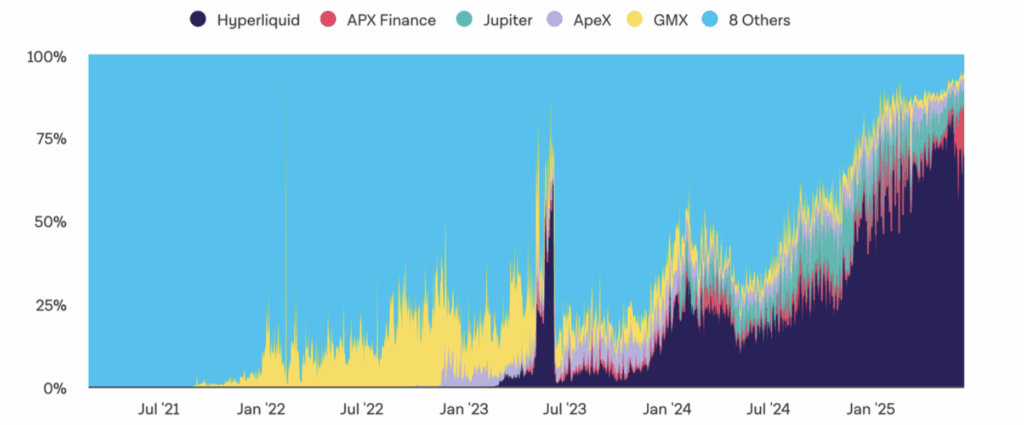- HYPE is up 300% since April, with Hyperliquid’s DEX moving $420M daily and $1.75B TVL
- FDV of ~$38B might seem crazy, but strong tokenomics and market share soften the blow
- Centralization remains the biggest caveat—speed is great, but resilience matters long term
Something’s cookin’. Since bottoming out back in April, HYPE—the native token of Hyperliquid—has exploded more than 300%. That’s right, triple digits. It even clocked a fresh all-time high this week before cooling off just a bit. Not bad for a protocol that’s, well, still flying under the radar for most of crypto Twitter.
But here’s the kicker: the blockchain underneath? It’s stealthily become one of DeFi’s top dogs. No fluff—$1.75 billion in total value locked puts Hyperliquid eighth among all chains, per DefiLlama. Its flagship DEX, sleek and fast as hell, is moving over $420 million a day. That’s sixth place among decentralized exchanges. Oh, and Nasdaq-listed Lion Group? Yeah, they just made HYPE their main treasury asset—allocating $600 million. Wild.
So… is this the real deal, or just the latest rocket fueled by speculation?
What’s Under the Hood of Hyperliquid?
Built by a couple of Harvard grads—Jeff Yan and Iliensinc—Hyperliquid launched in 2023 without a dime of VC cash. That alone’s pretty rare in today’s landscape. Their mission? Blend the self-custody and transparency of a DEX with the kind of speed you’d expect from a slick CEX.
And they’ve sorta done it. The user experience is snappy—one-click trades, seamless deposits from 30+ chains, support for spot, margin, and perps. Pretty frictionless. They even sidestep token bridges by using perpetual contracts pegged to token prices instead of transferring the tokens themselves. It’s clever… but it also means you sacrifice some composability.
Underneath it all is a custom L1, running a HyperBFT consensus variant—think ultra-fast Byzantine fault tolerance. It supposedly handles up to 200,000 transactions per second. But yeah, there’s a trade-off: decentralization. Right now, there’s only 21 validators on the network. Compare that to Ethereum’s 14,000+. Bit of a red flag for some folks.
Still, it exploded in November 2024. Daily trading volume spiked from $2B to $20B almost overnight. Today? Over 500,000 users are active on the thing.

Let’s Talk HYPE—The Token, Not Just the Buzz
Now for the money stuff. HYPE launched via airdrop last November—31% of its 1 billion token supply was handed out to early users. It became the largest airdrop in crypto history, with its market cap hitting $11B just a month later. Fast forward, and 334 million tokens are now worth $12.4B, giving it a fully diluted valuation (FDV) of around $38B. That’s… a lot.
HYPE’s utility? It’s the gas, the governance, the staking token. You can validate with it, stake it, vote with it. But does holding it really give long-term value?
Some aren’t convinced. Moonrock Capital’s Simon Dedic, for one, straight up said: “Love the project. Incredible execution. But who’s buying at $50B FDV? Like seriously?” Fair question.
But others argue the valuation gap is overstated. Hyperliquid owns 70% of decentralized perpetual trading right now but still only takes 10% of Binance’s total perps volume. That gap? Could be a big opportunity—especially if U.S. regulations get friendlier.
Also worth noting: HYPE’s tokenomics are super tight. The platform reinvests nearly all of its fee revenue—97%—back into HYPE through buybacks. Only 34% of tokens are circulating. Team tokens are locked ‘til 2027-28. And no VC overhead means no one’s dumping just to hit ROI targets.
So yeah, FDV is high… but maybe not absurd, depending on how you view long-term adoption.

Big Money’s Watching—But Centralization Lurks
Per analysts like Ansem, today’s buyers are probably late-stage VCs who missed the airdrop boat, TradFi guys running P/E models on crypto (lol), and whales rotating out of ETH and SOL into what they think might be the next big trading layer.
That could be bullish.
Still, there’s a philosophical dilemma brewing. Investors have always flocked to centralized stuff because it’s easier. But history’s shown—FTX, Celsius, pick your poison—that decentralization isn’t just a flex. It’s insurance against catastrophe. Hyperliquid’s validator set is tiny. That won’t matter… until it suddenly really does.














